
Swami Vivekananda, born Narendranath Datta, was an Indian Hindu monk, philosopher, author, religious teacher, and the chief disciple of the Indian mystic Ramakrishna. He was a key figure in the introduction of Vedanta and Yoga to the Western world; and is credited with raising interfaith awareness, and bringing Hinduism to the status of a major world religion. Vivekananda became a popular figure after the 1893 Parliament of Religions in Chicago, where he began his famous speech with the words, "Sisters and brothers of America...," before introducing Hinduism to Americans. He was so impactful at the Parliament that an American newspaper described him as, “an orator by divine right and undoubtedly the greatest figure at the Parliament”. After great success at the Parliament, in the subsequent years, Vivekananda delivered hundreds of lectures across the United States, England and Europe, disseminating the core tenets of Hindu philosophy, and founded the Vedanta Society of New York and the Vedanta Society of San Francisco, both of which became the foundations for Vedanta Societies in Western world.

Belur Math is the headquarters of the Ramakrishna Math and Ramakrishna Mission, founded by Swami Vivekananda, the chief disciple of Ramakrishna Paramahamsa. It is located on the west bank of Hooghly River, Belur, West Bengal, India. The temple is the heart of the Ramakrishna movement. It is notable for its architecture that fuses Hindu, Islamic, Buddhist, and Christian art and motifs as a symbol of unity of all religions. In 2003, Belur Math railway station was also inaugurated which is dedicated to Belur Math Temple.
Swamiji is a 2012 laser show and documentary film directed and produced by Manick Sorcar. Based on the life story of Hindu monk Swami Vivekananda (1863–1902), it is the first laser documentary made on an individual and the first full-length laser documentary ever to be shown in a performing arts center.

National Youth Day, also known as Vivekananda Jayanti, is celebrated on 12 January, being the birthday of Swami Vivekananda. In 1984 the Government of India declared this day as National Youth Day and since 1985 the event is celebrated in India every year.
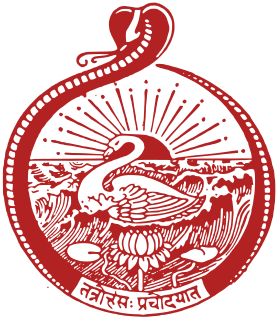
Ramakrishna Mission Vivekananda Educational and Research Institute, formerly Ramakrishna Mission Vivekananda University or simply Vivekananda University, is a education institute deemed-to-be-university headquartered at Belur, West Bengal, with campuses spanning multiple states in India. Established with the idea of actualizing Swami Vivekananda's vision of education, the institute is administered by the Ramakrishna Mission. The university provides courses on subjects as varied as rural and tribal development, disability management and special education, fundamental science education and Indian cultural and spiritual heritage.
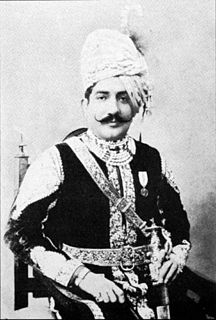
Ajit Singh or Raja Ajit Singh Bahadur was a ruler of Shekhawat dynasty of the Indian princely state of Khetri, Rajasthan between 1870 and 1901. He was born on 16 October 1861 in Alsisar, India. His father was Thakur Chattu Singh, a resident of Alsisar. Ajit Singh was later adopted to Khetri and after the death of Fateh Singh, he became the eighth king of Khetri in 1870. In 1876, he married Rani Champawatiji Sahiba and the couple had one son and two daughters. He died on 18 January 1901 at Sikandra, and was cremated at Mathura.

Swami Vivekananda is a 1998 Indian biographical film directed by G. V. Iyer and produced by T. Subbarami Reddy. It took Iyer 11 years to finish the research work required for the film and to write the screenplay.
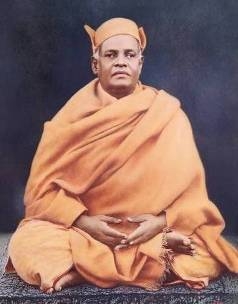
Saradananda, also known as Swami Saradananda, was born as Sarat Chandra Chakravarty in 1865, and was one of the direct monastic disciples of Ramakrishna. He was the first Secretary of the Ramakrishna Math and Ramakrishna Mission, a post which he held until his death in 1927. He established the Udbodhan house in the Bagbazar area of Calcutta, which was built primarily for the stay of Sri Sarada Devi in Calcutta, from where he used to publish the Bengali magazine Udbodhan. There he wrote Sri Sri Ramakrishna Lilaprasanga in Bengali, on the life of Ramakrishna, which was translated into English as Sri Ramakrishna, the Great Master. He is believed to be reincarnation of Saint Peter and he allegedly went into Samadhi when he was in the Saint Peter Church and said that "I remembered my past" and wrote in his diary that "Saint Peter again."

Nirmalananda, born as Tulasi Charan Dutta in Calcutta, was a direct disciple of Ramakrishna, the 19th-century mystic and Hindu saint from India, and took Sanyasa from Vivekananda along with Brahmananda and others. He was initiated by Sri Ramakrishna, on which fact a few latter-day antagonists tried to cast doubt in the Bangalore Court, but into which question the Court refused to get into. Nirmalananda played a key role in establishing Ramakrishna Math and Mission chiefly in South India, in Kerala and Bangalore and Tamil Nadu and also in the USA, Burma and Bangladesh.

Josephine MacLeod was an American friend and devotee of Swami Vivekananda. She had a strong attachment to India and was an active participant in the Ramakrishna Vivekananda movement. She was given the nicknames "Tantine" and "Jo Jo" by Vivekananda. She considered Swami Vivekananda to be her friend and helped him with his finances. MacLeod was not a sanyasin, unlike many others such as Sister Nivedita or Sister Christine. She was instrumental in spreading Vivekananda's message on Vedanta in the West. She made many contributions to the initial and the later phases of the development of the order of Ramakrishna and Vivekananda. She was a contributor to many causes espoused by Sister Nivedita, the most famous disciple of Vivekananda, including that of contributing financially towards the development of the Indian National Movement especially in Bengal and elsewhere in India.

Biley or Bilay is a 2012 Bengali drama created by Bengali theatre group Lokkrishti, This is a dramatisation of the life and works of Swami Vivekananda. Debshankar Haldar played the lead role. Phalguni Chattopadhyay directed this drama and Ujjwal Chattopadhyay was the playwright.
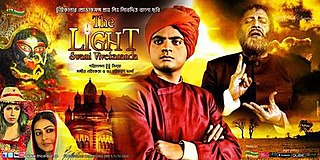
The Light: Swami Vivekananda (2013) is a bilingual film directed by Utpal (Tutu) Sinha and produced by Tri Colour productions private limited. The film is based on the life and teaching of Swami Vivekananda. The film was a tribute to Vivekananda on the 150th anniversary of his birth. The film was dubbed in 18 languages.

Swami Vivekananda was an Indian Hindu monk. He was a key figure in the introduction of the Indian philosophies of Vedanta and Yoga to the western world. The 150th birth anniversary of Swami Vivekananda was celebrated all over India and in different countries in the world. Ministry of Youth Affairs & Sports of India decided to observe 2013 as the year of 150th Birth Anniversary of Swami Vivekananda. Year-long events and programs were organised by different branches of Ramakrishna Math, Ramakrishna Mission, central government and different state governments of India, education institutions, youth groups etc. Bengali film director Tutu (Utpal) Sinha made a film The Light: Swami Vivekananda as a tribute to Swami Vivekananda on his 150th birth anniversary. The movie was released on 23 August 2013.

The Swami Vivekananda statue is a bronze statue of the Hindu Indian monk Swami Vivekananda (1863–1902), located in Golpark neighbourhood in the Indian city of Kolkata. The original statue, made of marble and unveiled in 1966, was the oldest statue of Swami Vivekananda in the city. The old statue was replaced by a new, taller one in 2005.

Ram Chandra Datta was a householder disciple of Ramakrishna and a writer. Datta was a relative of Indian monk and social reformer Swami Vivekananda. After completing his graduation, he took job of a Government employee and a chemist. He invented an antidote for blood dysentery from an extract of an indigenous medicinal plant and started promoting "modern science".

Baranagar Math or Ramakrishna Math, Baranagar was the first monastery of Ramakrishna Order. In September 1886, after the death of Ramakrishna, when his devotees stopped funding, Swami Vivekananda and other disciples of Ramakrishna decided to make a dilapidated house at Baranagar their new math. The house crumbled to dust in 1897. In 1973 Vivekananda Math Samrakshan Samity was formed who attempted to preserve the area. In 2001, the possession was handed over to Belur Math authority, who soon-after declared it as one of their official branch. The restoration and development work of the area is still going on.

The relationship between Ramakrishna and Vivekananda began in November of 1881 when they met at the house of Surendra Nath Mitra. Ramakrishna asked Narendranath to sing. Impressed by his singing talent, he invited him to Dakshineswar. Narendra accepted the invitation. The meeting proved to be a turning point in the life of Narendranath. Initially Narendra did not accept Ramakrishna as his master and found him "mono maniac", but eventually he became one of the closest people in his life. Ramakrishna reportedly shaped the personality of Narendranath and prepared him to dedicate his life to serve the humanity. After the death of Ramakrishna, Narendra and his other monastic disciples established their first monastery at Baranagar.
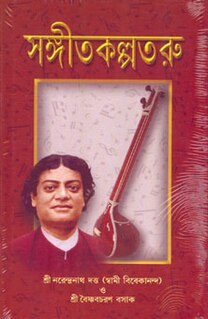
Sangeet Kalpataru is a Bengali language song anthology edited and compiled by Swami Vivekananda and Vaishnav Charan Basak. The book was first published in August or September 1887 from Arya Pustakalaya, Calcutta. In 2000, the book was reprinted by the Ramakrishna Mission Institute of Culture. It was edited with a critical introduction by Dr. Sarbananda Choudhury.

Vivekananda's prayer to Kali at Dakshineswar is the event in which Narendranath Datta, following the suggestion of Ramakrishna, went to the Kali temple of Dakshineswar with the intention to pray for financial welfare, but ultimately prayed for pure knowledge, devotion and renunciation. This event has been a subject of scholarly studies and is considered as a significant event in the life of Vivekananda, who initially revolted against idol-worship but now accepted and prayed before an idol of Kali. According to B. R. Kishore, "this incident added a new dimension to Narendra's devotion and knowledge".
Vishwanath Datta was a Bengali Attorney at law, philanthropist and novelist. He was the father of Swami Vivekananda, Mahendranath Dutta and Bhupendranath Dutta.























